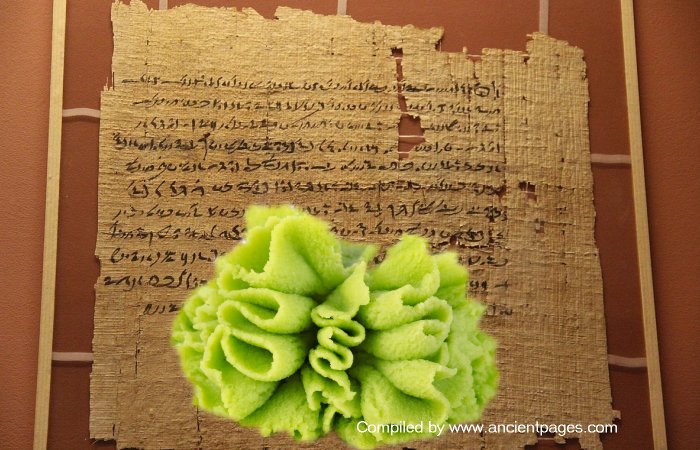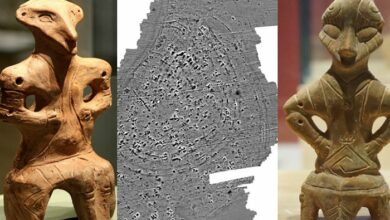Wasabi Plant Can Save Ancient Bio-Deteriorated Papyrus

Conny Waters – AncientPages.com – Preserving ancient documents from biodegradation has been a challenging task, but scientists have discovered that the Wasabi plant can protect papyrus from fungi and microorganisms.
Originating from Japan, the Wasabi plant thrives naturally in mountain river valleys, particularly along stream beds. Its use as a culinary ingredient can be traced back to as early as the 8th century AD. Enriched with Vitamin C and numerous antibacterial properties, Wasabi is a spicy green paste commonly served in traditional Japanese cuisine, notably sushi and sashimi.
In a recent study, scientists discovered that Wasabi also has the potential to preserve vital historical information for future generations.
In ancient Egypt, papyrus served as a significant medium for writing and was also utilized for various other applications, such as the construction of boats, basketry, cords, and sails. The usage of papyrus persisted throughout different eras, including Graeco-Roman Egypt, the Byzantine period, and the early Islamic age. Painted papyri are considered invaluable resources that provide insights into these ancient civilizations. Typically, the primary content was inscribed in black ink, while headings, instructions, keywords, and other crucial details were often emphasized using red ink.
To save ancient papyri is easier said than done. Microorganisms pose a persistent threat to invaluable historical documents, and past chemical approaches aimed at halting this deterioration have risked damaging the fibers in the writing and the pigments in the illustrations. Regrettably, neither ultraviolet radiation nor thermal processing has succeeded in eliminating these biological hazards without inflicting irreversible harm.
Therefore, scientists have, for the first time, studied Wasabi’s interference with different pigments of painted papyrus, and the results are promising.
The research was led by Hanadi Saada, a scientist at the Grand Egyptian Museum in Egypt. The team of scientists successfully replicated a papyrus dating back to 1,000 years. In an experiment spanning 120 days, the researchers subjected samples of the material to temperatures of 212 degrees Fahrenheit to simulate years of deterioration. Subsequently, they applied red, yellow, and blue pigments to the papyrus and exposed it to various fungal species typically observed on ancient manuscripts.
Next, the Wasabi was placed on aluminum foil close to the papyrus, with the imitation scrolls left open to the wasabi vapors. Upon revisiting after a period of three days, it was observed by the scientists that there was no trace of contamination. Interestingly, exposure to these vapors had also enhanced the sample’s tensile strength by 26 percent.
“Microbiological, mechanical, physical and chemical evaluations were carried out using various spectroscopic, tensile tester and microscopic tools. Wasabi vapors treatment for 72hs (2.5%) has eradicated the microbial growth of all the examined infected painted and non-painted papyri with inhibition efficiency of 100%.
Scientists are using the Wasabi to preserve ancient papyri. Credit: Adobe Stock – Wirestock Creators
The tensile strength of the treated papyri recorded enhancement by 26%, while maintained the color of painted and non-painted papyri without any noticeable change. Moreover, surface morphology of treated papyri has been evaluated and there was no change recorded. Additionally, FT-IR and EDX analyses revealed negligible chemical changes were attained.
Interestingly, upon long term treatment evaluation, which has been conducted based on the artificial aging of approximately 100 years, the papyrus samples remained unchanged, the scientists wrote in their paper published in Science Direct.
The science team said that the study provided a valuable understanding of the utilization of Wasabi for green conservation methods. This approach is not only safe for human interaction but also environmentally friendly. Furthermore, due to its fungicidal properties, it has been found to be effective in treating archaeological papyri without harming their intrinsic components.
The Grand Egyptian Museum in Giza will use this preservation method to preserve its ancient papyrus. The research team is exploring the potential of Wasabi as a preservative for materials like textiles and paper.
Written by Conny Waters – AncientPages.com Staff Writer
Copyright © AncientPages.com All rights reserved. This material may not be published, broadcast, rewritten or redistributed in whole or part without the express written permission of AncientPages.com
Al-Shehbaz, Ihsan A., and Suzanne I. Warwick. “A SYNOPSIS OF EUTREMA (BRASSICACEAE).” Harvard Papers in Botany 10, no. 2 (2005): 129–35. http://www.jstor.org/stable/41761810.
Hanadi Saada, Moamen Othman, Nour Attia, Maha Salah, Hanan Mohalhal, Yasunori Matsuda, Mona Khaleil, A safely green treatment of bio-deteriorated painted archaeological papyri by Wasabi, Journal of Archaeological Science, Volume 163, 2024, 105936, ISSN 0305-4403,
https://doi.org/10.1016/j.jas.2024.105936.






